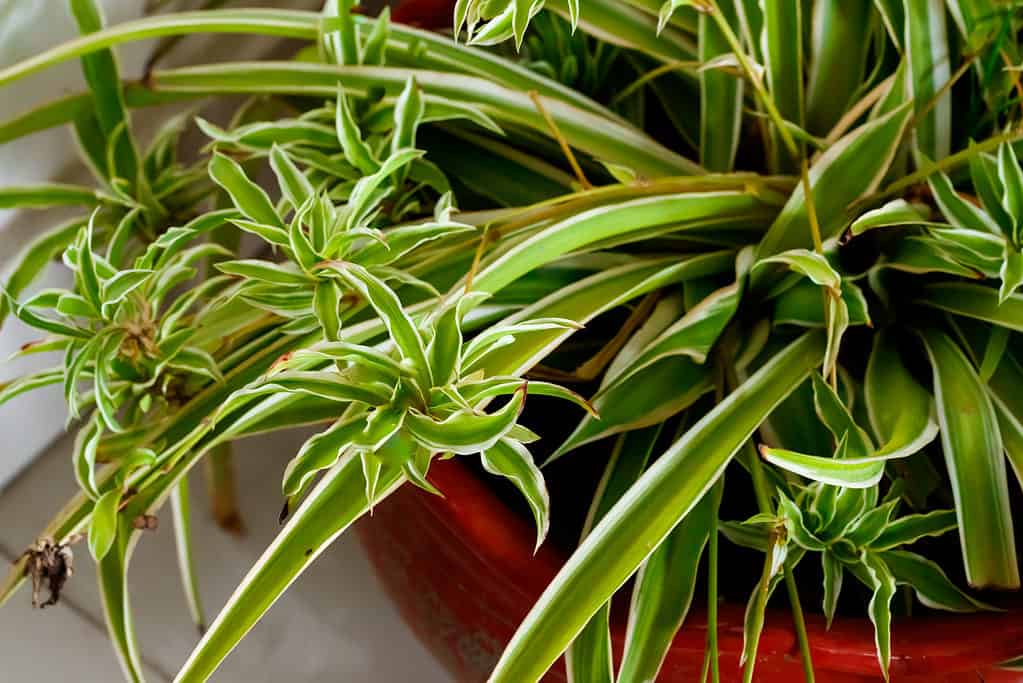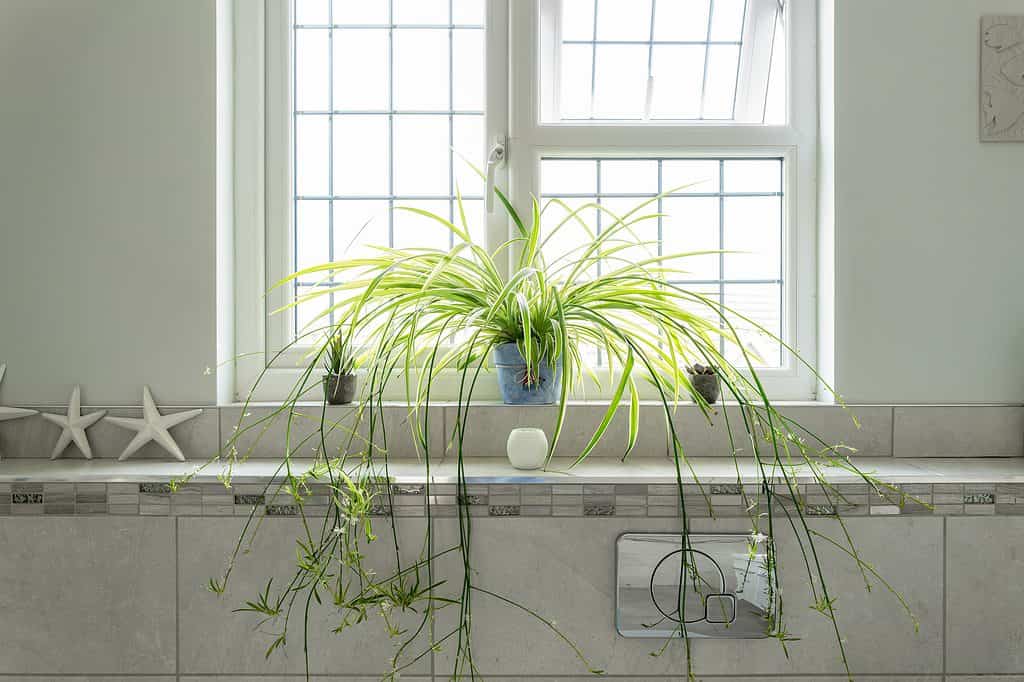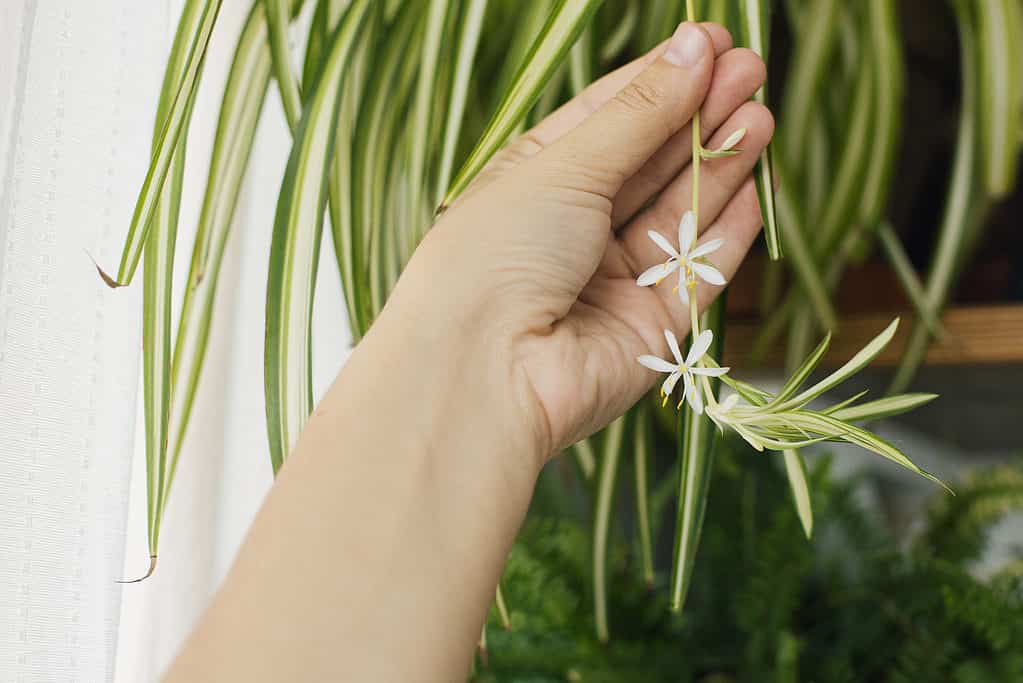Because they require little maintenance and can tolerate neglect, spider plants (Chlorophytum comosum) are among the most common indoor plants. Despite their reputation for thriving in low-light environments, spider plants do have particular temperature and lighting requirements that must be met in order for them to flourish.
The amount of light that spider plants need to thrive is one of the most crucial aspects to take into account. Spider plants may survive low light levels but often prefer bright, indirect light. As long as they are not subjected to abrupt temperature fluctuations, they will also survive a broad variety of temperatures. Place your spider plant close to an east or west-facing window if you’re growing it inside. Place your spider plant in a location that receives intermittent indirect sunlight if you’re growing it outdoors. Spider plants are a wonderful choice for workplaces and other business settings since they can thrive under fluorescent lighting.
In this in-depth guide, we’ll break down the basics of providing the right amount of light and temperatures for your spider plant.
Determining How Much Light Your Spider Plant is Getting
Your eyes aren’t built to measure light intensity precisely. You cannot determine if a plant receives low, medium, or bright light just by using your eyeballs. There is a great solution, though. Try the shadow test to see how much light your spider plant receives.
The hand shadow test is a quick and easy way to determine how much light a houseplant receives without spending any money. It entails estimating the amount of light hitting a certain region by measuring the strength of the shadow your hand casts.
Select the location in your room where you want to put your spider plant first. Place your palm approximately 12 inches immediately up above the place at midday, when the sun is at its brightest. For better results, you can use a white piece of paper. Look at the shadow your hand or paper has made. A bright spot is when you see a sharp, high-contrast, and clearly defined hand shadow. An identifiable hand shadow that is slightly fuzzy, blurry, or hazy will be produced by medium light. A shadow in low light will have a blurry shape and be dim, and hardly visible.
Remember that the hand shadow test is the least accurate technique. You may use it to get a ballpark idea of how bright the light in a certain area is. A lux meter, which you can get from your neighborhood hardware store or nursery, can be used if you’re interested in a method that is more exact.

Spider plants (pictured) can suffer from brown tips and other leaf problems if deprived of light.
©iStock.com/niuniu
Signs of Spider Plant Light Deprivation
There are a few indicators that your spider plant isn’t getting enough light that you could notice.
To start, your plant may be gravitating toward light sources. It should come as no surprise that spider plants require light in order to photosynthesize and thrive, just like any other plant. If the spider plant is not receiving enough light, its leaves will tilt toward the light source.
The soil of your plant can also have a strong smell. Drying the plant’s potting soil requires a lot of light. The soil takes weeks to fully dry after being exposed to low light. When the plant receives enough sunshine, the potting soil dries up rapidly because light accelerates the soil’s loss of moisture. If there is not enough light, the soil will smell like it is decomposing. The soil of the spider plant typically has a wonderful earthy musk smell.
Another sign of inadequate illumination is the discoloration of your spider plant’s leaves. Your spider plant will likely become undernourished if it does not receive enough light. Leaves that usually resemble healthy green grass become yellow. After one leaf turns yellow, the color of all other plant leaves begins to change fairly quickly as a result of poor lighting. Along with becoming yellow, the leaves also take on the appearance of having been washed out. It occurs because a lack of exposure to light causes the leaves to lose their chlorophyll gradually.
Lastly, if your spider plant is not receiving enough light, it may not produce any new growth. Despite their exceptional adaptability and ability to survive in low-light environments, spider plants don’t exhibit any further development in poor lighting. Your plant can stop growing as well as start to wilt.
Signs of Spider Plant Light Oversaturation
If you’re concerned that your plant is receiving too much light, there are a number of symptoms to look out for. One sign of too much light is when the leaf stripes become very vivid and bright-colored. The main indication that a spider plant is receiving too much light is when the stripes on its leaves start to stand out excessively. Simply said, excessive illumination causes the white or yellow hue of the stripes to become brighter than usual.
The plant’s leaves may also begin to curl if exposed to too much light. Arched leaves are a sign of a thriving spider plant. However, if exposed to excessive light, the heat generated causes the spider plant to lose significant moisture. The spider plant may lose more moisture than it receives through its roots if exposed to too much sun.
Tissue damage can also result from underwatering your spider plant when it is exposed to intense sunshine. The heat from too much sun exposure causes the spider plant to lose moisture. The spider plant’s browning leaf tips are one of its outward signs. The entire plant’s leaves will get dry and brown from sunburn if the spider plant is left in the sun for an extended period of time.
How Much Light Does a Spider Plant Need?
For a spider plant to flourish, it needs bright and indirect sunshine. Ensure that your spider plant receives six to eight hours of direct sunshine each day or slightly more during the wintertime. The spider plant is native to southern African forests, where it thrives in the shade of tall trees. Thus, in its native environment, the plant receives medium to bright indirect illumination and some shade from the tree canopy. Therefore, we must provide the spider plant with a similar habitat if we want it to flourish indoors. When there is enough light, the white or yellow stripes on the leaves will stand out and become more exquisite.
Under five hours should be the maximum amount of time spent in direct sunlight if indirect sunlight cannot be provided, such as in outdoor spaces. The leaves will scorch and get brown patches if exposed to too much light for an extended period. Additionally, the leaf tips will start to darken in too much sun. Keep in mind that spider plants tend to survive best in USDA hardiness zones nine through 11.
Make sure your spider plants are exposed to light for four to five hours when it comes to artificial lighting of any type. In this instance, a lower minimum is advised because the source will likely be a little more direct and certain artificial lights can be harsh. We generally advise keeping your spider plant in real sunlight over artificial lights.

When spider plants (pictured) are exposed to the right intensity of light, they can grow quite fast.
©Nick Beer/Shutterstock.com
The Right Light Intensity for Spider Plants
Depending on the circumstances, the spider plant’s requirement for light intensity might change. Although you may need to experiment to achieve the ideal mix of light intensity for optimal development, the spider plant generally enjoys medium to bright light.
Although spider plants don’t require a certain light intensity level to obtain optimal light, it would probably be preferable to note that 100 to 1,000 foot-candles is the correct range. Your spider plants should be exposed to medium to high light intensities, ranging from 100 to 1,000 foot-candles.
Any light intensity of more than 10,000 lux, or 1,000 foot-candles, is considered direct light. As a result, spider plants shouldn’t be grown in areas with light levels below 25 foot-candles. A candle’s length should be between 500 and 1,000 foot-candles for artificial light.
Where to Place Your Spider Plant for Optimal Sunlight
In practically every area of the house and occasionally even outside, spider plants thrive. The important thing is to provide them with enough filtered or indirect light, medium to high humidity levels, and consistent interior temperatures. Spider plants benefit from any healthy or pleasant temperature for humans, such as room temperature. The ideal air temperature for growth is between 70 and 90 degrees F. Although spider plants may survive in temperatures as low as 35 degrees F without suffering any harm, they do not thrive or even really grow in temperatures below 65 degrees F.
Windows facing south typically get the most direct sunlight. Therefore, it is advised to position the plant in this situation at least a few feet away from the window.
Spider plants will also be content if there is some shade for a portion of the day. They should likewise avoid being overexposed to the sun. Your spider plant will often thrive in front of an east or south-facing window. In this manner, it will be able to absorb the earliest sunshine possible. However, your spider plant won’t be subjected to the full force of the sweltering afternoon sun.
A window facing west could work, but it should be five to six feet away from your spider plant. Ensure that your west-facing window has a sheer screen or drape so that your plant may get brilliant, filtered light.

Without sunlight, spider plants (pictured) will not flower or grow.
©iStock.com/Bogdan Kurylo
Can Spider Plants Survive Without Light?
No plant can survive without any light long-term. That being said, spider plants are one of the few common houseplants that can endure low light. However, medium to bright indirect light is optimum for growing spider plants. Expecting it to flourish in a dim area is unrealistic. It will develop slowly and might not produce any spectacular plantlets or spiderettes. Low light levels may further exacerbate the negative impacts of disease, infestation, overwatering, drafts, and nutritional shortages. To put it simply, your spider plant doesn’t need much light, but it does need at least some light to thrive.
Spider plants are quite hardy little houseplants and can tolerate quite a bit in terms of lighting and temperature. By following this guide, you’ll be able to provide the perfect conditions for your spider plant so that it will flourish and maintain its foliage’s lovely color.
Do you want to learn even more about the incredible and resilient spider plant? Take a look at our complete guide to spider plants here!
The photo featured at the top of this post is © iStock.com/Greenseas
Sources
- NCSU Staff / Accessed December 29, 2022
- Susan Mahr / Accessed December 29, 2022
- Brandon Lobo / Published February 15, 2022 / Accessed December 29, 2022
FAQs (Frequently Asked Questions)
Do indoor spider plants require a window?
Yes. Spider plants enjoy medium or bright light. Low light, or a lack of access to a window, will cause these plants to become saggy.
Can spider plants survive in low light?
Yes, the spider plant can survive in low light. However, it still needs some light, or else it will start drooping.
How many hours should my spider plant get sunlight?
Six to eight hours is the general amount of time your spider plant should be exposed to bright, indirect light.
Thank you for reading! Have some feedback for us? Contact the AZ Animals editorial team.







